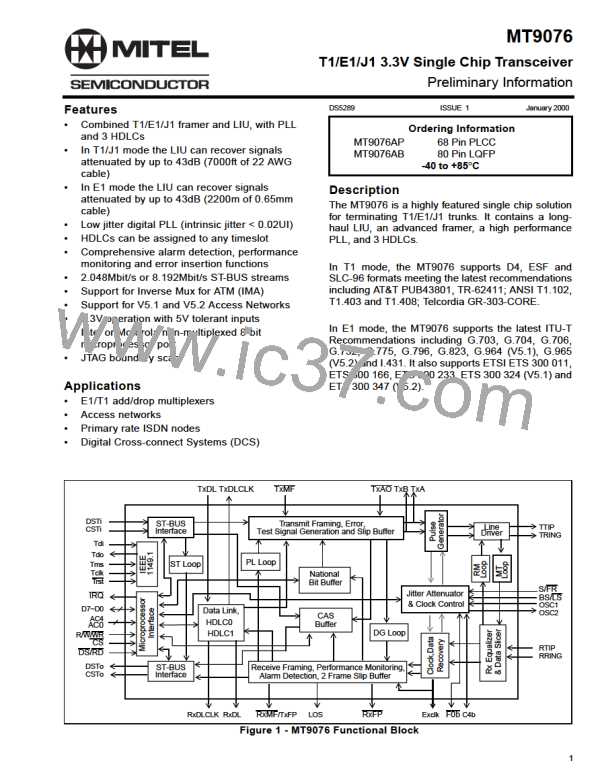MT9076
Preliminary Information
AUTC
ARAI
TALM
Description
0
0
X
Automatic CRC-interworking is activated. If no valid CRC MFAS is being received,
transmit RAI will flicker high with every reframe (8msec.), this cycle will continue
for 400 msec., then transmit RAI will be low continuously. The device will stop
searching for CRC MFAS, continue to transmit CRC-4 remainders, stop CRC-4
processing, indicate CRC-to-non-CRC operation and transmit E-bits to be the
same state as the TE control bit (page 01H, address 16H).
0
0
1
1
1
0
0
1
X
Automatic CRC-interworking is activated. Transmit RAI is low continuously.
Automatic CRC-interworking is activated. Transmit RAI is high continuously.
Automatic CRC-interworking is de-activated. If no valid CRC MFAS is being
received, transmit RAI flickers high with every reframe (8 msec.), this cycle
continues for 400 msec, then transmit RAI becomes high continuously. The
device continues to search for CRC MFAS and transmit E-bits are the same state
as the TE control bit. When CRCSYN = 0, the CRC MFAS search is terminated
and the transmit RAI goes low.
1
1
1
1
0
1
Automatic CRC-interworking is de-activated. Transmit RAI is low continuously.
Automatic CRC-interworking is de-activated. Transmit RAI is high continuously.
Table 12 - Operation of AUTC, ARAI and TALM Control Bits (E1 Mode)
3.3.3
CAS Signaling Multiframing in E1 mode
The purpose of the signaling multiframing algorithm is to provide a scheme that will allow the association of a
specific ABCD signaling nibble with the appropriate PCM 30 channel. Time slot 16 is reserved for the
communication of Channel Associated signaling (CAS) information (i.e., ABCD signaling bits for up to 30
channels). Refer to ITU-T G.704 and G.732 for more details on CAS multiframing requirements.
A CAS signaling multiframe consists of 16 basic frames (numbered 0 to 15), which results in a multiframe
repetition rate of 2 msec. It should be noted that the boundaries of the signaling multiframe may be completely
distinct from those of the CRC-4 multiframe. CAS multiframe alignment is based on a multiframe alignment
signal (a 0000 bit sequence), which occurs in the most significant nibble of time slot 16 of basic frame 0 of the
CAS multiframe. Bit 6 of this time slot is the multiframe alarm bit (usually designated Y). When CAS
multiframing is acquired on the receive side, the transmit Y-bit is zero; when CAS multiframing is not acquired,
the transmit Y-bit is one. Bits 5, 7 and 8 (usually designated X) are spare bits and are normally set to one if not
used.
Time slot 16 of the remaining 15 basic frames of the CAS multiframe (i.e., basic frames 1 to 15) are reserved
for the ABCD signaling bits for the 30 payload channels. The most significant nibbles are reserved for channels
1 to 15 and the least significant nibbles are reserved for channels 16 to 30. That is, time slot 16 of basic frame
1 has ABCD for channel 1 and 16, time slot 16 of basic frame 2 has ABCD for channel 2 and 17, through to
time slot 16 of basic frame 15 has ABCD for channel 15 and 30.
4.0 MT9076 Access and Control
4.1
The Control Port Interface
The control and status registers of the MT9076 are accessible through a non-multiplexed parallel
microprocessor port. The parallel port may be configured for Motorola style control signals (by setting pin INT/
MOT low) or Intel style control signals (by setting pin INT/MOT high).
30

 MITEL [ MITEL NETWORKS CORPORATION ]
MITEL [ MITEL NETWORKS CORPORATION ]